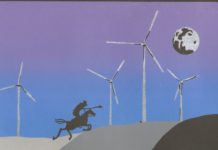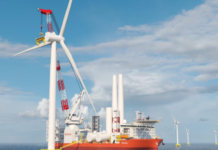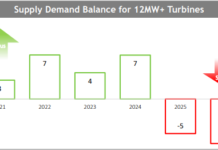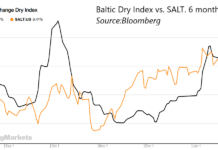Debra Fiakas
Angela Merkel’s coalition government may not have looked at the nuclear power question for anything more than a “cover your behind” solution. Nonetheless, the wind industry sees last month’s decision to phase out Germany’s nuclear power generation industry by 2022 as – no pun intended – a windfall. Policy makers say as much as half of the deficit left by the shutdown of nuclear power plants will need to be made up from other power sources, principally wind power.
This is no small undertaking. A total of 21,607 wind turbines with an overall capacity of 27,214 MW were in service in Germany at the end of 2010. To replace half of the nuclear power capacity going off-line by 2022, wind installations need to increase by as much as 40% by 2022. German Wind Energy Institute (DEWI) reports that 1,551 MW of new wind power capacity was installed in 2010, well below goals for 1,900 MW installations. The German wind power industry will need to maintain if not accelerate its current pace of development in order to meet Merkel’s nuclear replacement goal. This means many new wind turbines sprouting up across the German countryside.
The most logical winner in this turn of events is Germany’s own Siemens AG (SI). Siemens has dedicated considerable investment in developing its line of seven wind turbines models. The company boasts 7,800 turbines installed around the world, producing over 8,800 MW of power a year. For U.S. investors Siemen’s ADR has some appeal as it is priced at a multiple of 11.4 times forward earnings and offers a 2.8% dividend yield. However, the stock trades not on its wind power business but on the relative strength of worldwide earnings against currency fluctuations and other macroeconomic factors.
Germany’s Nordex (NRDXF.PK) lays claim to first-mover status in the wind power world. In 1995 with already a ten year track record in the wind business, Nordex was the first to put a megawatt system on the market. Since its inception Nordex has installed more than 4,400 Nordex wind turbines with a total rated output of more than 6,500 megawatts in 34 countries around the world. Of its large turnkey projects only a small portion are located in Germany. Expect Nordex to make some aggressive moves to get a larger part of the domestic market.
Denmark’s Vestas Wind Systems (VWDRY.PK) is not in the least intimidated by the Siemens/Nordex home advantage. That is because Vestas has installed over 43,000 turbines around the world with capacity to produce over 44,000 MW of power. Over 5,800 of those turbines are in German and Vestas is likely to use its track record in Germany to get another big bite of the strudel so-to-speak. That fact that Vestas does not report its financial results in the U.S. should not be a deterrent for U.S. investors. The company provides financial information in English on its corporate web site. Vestas ADRs trade on the Pink Quote system in the U.S. with fairly good volume and the bid/ask spread is reasonable. Otherwise it is necessary to pick up shares on the Danish exchange.
For small-cap sector purists it will be necessary to consider at PNE Wind (PNE3.DE) and REpower Systems AG (RPW.DE). Both are Germany-based wind technology companies that are likely beneficiaries of domestic wind power policies.
With a knack for developing and installing wind power projects, PNE Wind recently broke into the U.S. market with the sale of a wind farm to Black Hills Power near Belle Fourche, South Dakota. (As a native, I can vouch for the fact that there are a lot of Germans in South Dakota.)
REpower Systems is another wind turbine producer with a full product portfolio that ranges from wind turbines with an output from 1.8 MW up to 6.15 MW and rotor diameters from 82 up to 126 meters. It boasts the ability to install workable solutions even in areas with weak wind experience.
In scrutinizing these company’s investors will need to take a magnifying glass to cash flows and capital expenditures. Even a whiff of inadequate resources for investment would be a tip to stay away from long positions. Also a good look at product portfolios would be helpful as sites for eventual wind power installations are identified. Not all turbines are created equal and some may not be the right configuration for Germany’s landscape.
Debra Fiakas is the Managing Director of Crystal Equity Research, an alternative research resource on small capitalization companies in selected industries.
Neither the author of the Small Cap Strategist web log, Crystal Equity Research nor its affiliates have a beneficial interest in the companies mentioned herein. All stocks mentioned in this article are included in Crystal Equity Research’s Earth, Wind and Fire Index in the Wind Group.







